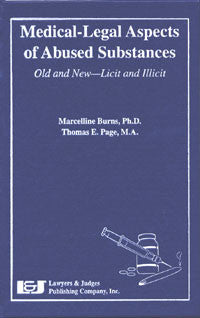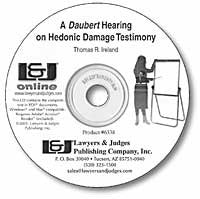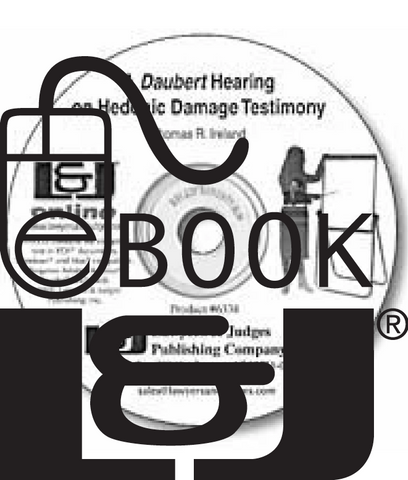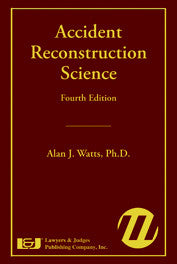
Medical-Legal Aspects of Abused Substances: Old & New--Licit & Illicit
-
Author: Marcelline Burns, Thomas E. Page
-
ISBN 10: 1930056834
-
ISBN 13: 978-1930056831
-
Copyright Date Ed: July 26, 2005
-
Pages: 248 pages
-
Binding Information: Hardcover
- Size: 6 ✕ 9 Inches (US)
If you handle cases involving substance abuse or need detalied information on newly compounded substances, as well as re-discovered drugs of abuse such as Ecstasy, Meth, PCP, Gamma Hydroxy Butyrate, one of the most common “Date Rape" drugs, and Anabolic-Androgenic Steroids popular with today’s athletes, this is your reference of choice. Its extensive chapters are devoted to the above substances as well as other popular drugs of abuse.
The authors discuss the role of law enforcement officers in abused substance cases, double standards in enforcing substance abuse laws, driving under the influence of drugs as opposed to alcohol, and legal and prosecution perspectives regarding these drug cases. This book contains much valuable information and is a must for anyone who regularly deals with prosecuting or defending substance abuse cases.
As drug use is an international problem, the authors also present case studies of Turkey and Australia’s laws pertaining to abused substances and driving, and how they were developed. This information is particularly valuable to those involved in the creation of substance abuse legislation, here in the US and around the world.
This book is also available as an E-book. E-book price: $79.00. Click here to purchase and download:
Table of Contents:
Chapter 1: The Science of Drug Influence
1.1 Introduction
1.2 The Study of Drug Effects
1.3 Epidemiological Study
1.4 Laboratory Experiments
1.5 Illicit Drugs
A. Marijuana
B. Stimulants
1.6 Therapeutic Drugs
1.7 Summary and Conclusions
Chapter 2: The Role of the Law Enforcement Officer
2.1 Introduction
2.2 Alcohol Versus Drugs
2.3 Trafficking, Manufacturing, and Diversion
2.4 Driving Under the Influence Enforcement
2.5 Non-Driving Under the Influence Offenses
2.6 DRE Drug Categories
2.7 DRE Procedure
2.8 The Art and Science of DRE Reconstruction
2.9 The DRE crime scene
2.10 Direct/Indirect Evidence of Drug Use
Chapter 3: Drug Impaired Driving Fundamentals
3.1 Introduction
3.2 The Scope of the Problem: Prevalence of drug-impaired driving?
3.3 Alcohol versus Drug-Related DUI: Alcohol is a drug, but not all drugs are alcohol
3.4 Prevalence of Drugs in DUI: Which drugs are most frequently encountered?
3.5 Common Drug Effects: Pharmacology Basics
A. Pharmacology
B. Pharmacokinetics
C. Route of administration
D. Absorption
E. Distribution
F. Metabolism
G. Elimination
H. Pharmacodynamics
3.6 How Do Drugs Affect Driving? Relating drug effects to driving impairment.
3.7 Measuring Impairment: The scientific literature
3.8 Case Interpretation: Is this driver impaired by drugs?
3.9 Testing Methodology: The forensic toxicology laboratory
A. Screening tests
B. Confirmatory tests
3.10 Conclusions
3.11 Acknowledgements
Chapter 4: The Legal and Prosecution Perspective of Drug Impairment
4.1 Introduction
4.2 Drugs In General
4.3 Legal and Illegal Drugs
4.4 Drug Impairment
4.5 Drug Per Se Laws
4.6 Possible Solutions
4.7 Educate Thyself
4.8 Conclusion
Chapter 5: A True Double Standard: A Defense Perspective on the Inherent Unfairness in the Administration of the Impaired Driver Laws
5.1 Introduction
5.2 The Initial Stop
5.3 Roadside Detention/Interrogation
5.4 Post-Arrest Detention/Interrogation
5.5 Chemical Tests
5.6 Chemical Test Refusals
5.7 Miscellaneous Issues
5.8 Conclusion
Chapter 6: Examining MDMA: 3,4-methyl-enedioxymeth-amphetamine (Ecstasy)
6.1 Introduction
6.2 History and Background
6.3 Development and Delivery
6.4 Appearance and Routes of Administration
6.5 Counterfeits
6.6 Analogs
6.7 Effects
6.8 Toxicity
6.9 Driving
6.10 Summary
Chapter 7: Examining Methamphetamine
7.1 Introduction
7.2 Forms
7.3 History
7.4 Appearance
7.5 Methods of Administration
7.6 Legislative Control of Methamphetamine
7.7 Patterns of Use and Abuse
A. Low-intensity abuse
B. High-intensity abuse
C. Binge and crash
D. Withdrawal
E. Methamphetamine psychosis
7.8 Identifying a Methamphetamine Addict
7.9 Chemicals
A. Precursors
B. Reagents
C. Solvents
D. Catalyst
7.10 Methamphetamine Labs
7.11 Methods
A. P2P amalgam method
B. Red phosphorus (P) reduction (hydriodic acid method, cold method)
7.12 Conclusion
Chapter 8: Jimson Weed, Inhalants, and Hallucinogens
8.1 Introduction
8.2 Jimson Weed
8.3 Inhalants
A. Solvent inhalation
B. Volatile nitrites (Romanelli, Smith, Thornton, and Pomeroy, 2004)
C. Nitrous oxide
D. Hallucinogenic drugs (Nichols, 2004; Laing, 2003)
Chapter 9: PCP (Phencyclidine)
9.1 Overview and Classification
9.2 Origin and History
9.3 Name Identification of PCP
9.4 Identification of PCP by Appearance and Packaging
9.5 PCP- Related Behavior
9.6 Signs and Symptoms of Influence
9.7 Danger is Real
9.8 A Contamination Hazard
9.9 Methods of Administration
9.10 PCP Production
9.11 Driving Under the Influence
9.12 Lethal Consequences
9.13 Ketamine: An Overview
9.14 Conclusions
Chapter 10: Gamma Hydroxy Butyrate (GHB)
10.1 Introduction
10.2 Drug-Facilitated Sexual Assault (DFSA)
10.3 GHB and Driving
10.4 GHB and Robbery
10.5 Addiction
10.6 Senior Citizens at Risk
10.7 GHB Analogs
10.8 Testing Issues
10.9 Xyrem Approval and Diversion
10.10 Conclusion
Chapter 11: Anabolic-Androgenic Steroids
11.1 Introduction
11.2 Pharmacology and Physiology
11.3 Undesirable Side Effects
11.4 Steroids and Aggression
11.5 Analysis in Biological Matrices
11.6 Summary
Chapter 12: The Turkish Experience in the Development of Laws and Policies Regarding Alcohol- and Drug-Impairment
12.1 Introduction
12.2 Brief Description of the Country
12.3 Consumption of Alcohol and Drugs in Turkey
A. Alcohol consumption
B. Drug abuse data
C. Treatment demand
12.4 Road Traffic Accident Statistics
A. Official statistics related to driving under the influence of alcohol and drugs
B. Scientific study of driving under the influence of alcohol and drugs
12.5 Legislation Regarding Driving under the Influence of Alcohol and Drugs
A. Alcohol and substance use and the Turkish criminal law
B. Highway traffic law
C. Enforcement of the Highway Traffic Law (HTL)
D. Activities for the prevention of traffic accidents
12.6 Activities on Accident Prevention
A. The parliamentary traffic safety commissions
B. Five-year development plans of the Prime Ministry State Planning Organization
C. The Traffic Research Center
D. Academic research
Chapter 13: Drugs and Driving - Victoria, Australia
13.1 Introduction
13.2 Legislative Framework
13.3 2001 Drug Impairment Legislation
A. Procedure overview
B. Enforcement personnel training
C. Procedure evaluation
13.4 General Deterrence Legislation
A. Alcohol
B. Illicit drugs
C. Drug screening technology
D. 2003 random saliva testing for drugs legislation
E. Operation of the 2003 random saliva testing for drugs legislation
13.5 Conclusion




